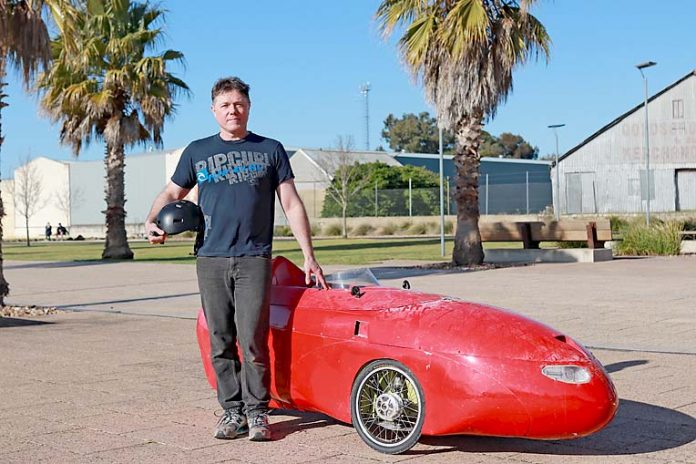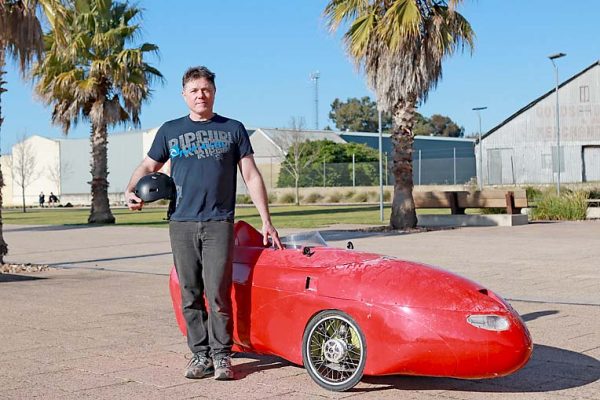

A MOUNT Gambier-based bike manufacturer has taken a European concept and adapted it for the Australian market to create a head-turning, practical mode of transport for the general public.
In August last year, Brett Turner and Geoff Wood had their first velomobile prototype road-worthy approved, with the quirky tricycle travelling over 10,000km across Australia.
Reaching speeds of up to 50kph, the human-powered vehicles offer enclosed aerodynamic advantage and protection from weather and are similar to bicycles, pedal gokarts and tricycles, but with a full fairing aerodynamic shell.
Mr Turner and Mr Wood’s bright red creation has likely been spotted on more than a few occasions touring the Mount Gambier Railway Lands or around town, showcasing the alternate mode of transport.
Spotting a gap in the national market a few years ago, Mr Turner said the idea started when he was tasked to build a pedal human powered vehicle for his children’s school team.
“When I was trying to find parts, I discovered local manufacturer G Trikes, which is managed by Geoff Wood,” Mr Turner said.
“He builds bikes for half the country from his back shed and we ended up becoming good friends.
“We are not doing anything new, but are simply doing an Australian version suited for the Australian environment.”
Mr Turner said in Europe the velomobile was gaining a following because of the continent’s developed bike infrastructure and large costs associated with road registration and taxes.
“One of my internet friends works in Rotterdam and if he takes his car to work, it is 15 Euro each day as a congestion charge when he crosses over a tagline,” he said.
“He was riding a pushbike because he was only 14km away, but he then bought a velomobile as he could ride all year round and once you are fit, it is easy to do 50kph.
“There is approximately 50 units a day being sold in Europe and although it is not car numbers, it is quite large when you take into consideration it is something people have barely heard about.”
Mr Turner said Australia had been targeted before in the 1980s when a factory was established in Melbourne.
Mr Wood bought the factory outright last year and shipped all its materials to Mount Gambier with Mr Turner – a qualified aircraft engineer – helping to build and develop the transport units.
“Australia has a good level of bike infrastructure and people are importing them out of Europe new and are paying the price,” Mr Turner said.
“They are around 10,000 Euro on the ground, plus freight and GST so you can be looking at a good $20,000 for one unit.
“People who are buying them are living in the cities, generally Sydney, Melbourne and Adelaide and it answers all their problems.”
The aircraft engineer estimated owners would make their money back in savings from parking and transport costs after two years.
“We have been trying to get it out all over the country which has been excellent as we have been able to incorporate the changes people have suggested and have taken any feedback on board,” he said.
“We are building the new evolution from scratch at the minute which we plan to have finished by the end of the year.
“This is a factory production bike which we have done a lot of modification on to improve it and bring it into modern day.”
Mr Turner said interest was growing, but the idea was still unknown to many.
“At the moment it is selective, but I do think it is going to be for the general public,” he said.
“People look at it, they do not know what it is, how it works and there is just a million questions which puts people off at this point.
“People who are testing them out are doing us a huge favour because now others are slowly getting used to seeing them.”
Taking around one to three months to manufacture each unit, Mr Turner said the focus would be to make around 15 each year, keeping the design simple and modern.
“It is very simple and we want to keep it that way so people can just look at it and see a pushbike,” he said.
“If demand was there, it would be pretty easy for us to step into serious manufacturing.
“We plan to have pre-production velomobiles ready by the end of the year.”





